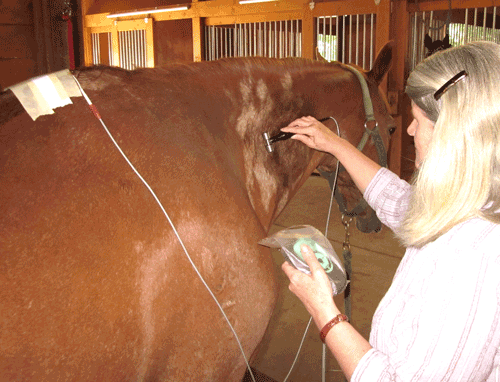A MicroCurrent Therapist: An Interview with Tracey Barrett Webb
By: Nikki Alvin Smith
Tracey Barrett Webb is the wife of a veterinarian in Ocala, FL. Her husband, Brent Barrett, DVM, who specializes in equine podiatry, is also a proponent of microcurrent therapy.
When did you first learn about the benefits of micro-current therapy?
It was about fifteen years ago that I went to a pain clinic in Phoenix, AZ, for the low back issue from a fusion. The doctor used the Acuscope/Myopluse microcurrent system. It worked so well that I purchased my machines and trained them to work on racehorses in Louisiana.
How did you learn about Matrix Therapy Products?
I was shopping for microcurrent supplies. Matrix had small units that looked very appealing compared to my large equipment. Deborah Powell, the owner, is knowledgeable about the different units and adjunct therapies. I have added the Best Vet, Best Vet III, the MicroPlus, and Micro-400 to my inventory of microcurrent devices.
What was your therapy regimen, and how did the therapy help you?
Microcurrent is the only thing that helps my nerve pain. I have a metal rod in my back from getting bucked off a horse, so I have multiple issues going on. Microcurrent dramatically increases the quality of my life.
What do you use microcurrent therapy for in horses?
My husband is an equine vet, and after getting my equipment, I managed show barns, so it was an easy transition to start offering therapy services. Most show horses have issues. I worked with a girl who did one of the top hunter/jumper trainers’ horses daily at the shows. Microcurrent is excellent for sore backs, legs, and feet.
Did you have a specific regimen?
Every horse is different depending on the problem. One horse has chronic SI problems, which affect the whole hind end. For time purposes, I use multiple machines. Each has unique equine features, and Deborah at Matrix Therapy Products is great for helping with which device is best for what. Suppose I am only doing a particular horse once a week for soreness; then I would roller everything (the roller connects to the microcurrent device). The result is the spasmed muscles soften, and the pain is relieved.
What about other injuries?
I have worked on torn suspensory ligaments that heal with no scar tissue and in record time. I have used it on my shoulders and got the muscle reactivated and working. I have worked on Dachshunds that couldn’t use their hind legs, and in three treatments, they could walk.
Could you tell me about your experience regarding rehab facilities?
In Europe, horses have osteopaths and physical therapy. Here, we have rehabilitation facilities. We have equipment for primarily exercising injured horses instead of physical therapy for each condition. The treatments here are Shock Wave, PRP, Stem Cell, etc, which a veterinarian does. The rehab facility can have hot walkers, aqua tread, a cold water leg spa, a Hyperbaric Chamber, swimming, and other exercise modalities. The rehab may use laser and PEMF also.
Have you seen/had experience with microcurrent therapy being used at rehab facilities?
I have worked at rehab centers with the vet’s permission. Many compare PEMF and regular TENS to microcurrent and need help understanding the differences. They are always impressed with microcurrent results, yet it rarely get the credit it deserves. Maybe they feel it is too complicated or labor-intensive. They overlook the outcome, which is the entire point.
Do you believe rehab facilities could do more to care for their equine patients?
Yes. We need physical therapists trained to do exercise with horses to decrease the recovery time and improve the result. They need treatments to reduce recovery time, such as microcurrent. Most leg injuries could heal faster with less scar tissue if microcurrent were used.
What do you think a horse owner can do to serve better their horses needing rehab when they pay to put their horse in a rehab facility?
I would look for microcurrent services in your area. For much less than a rehab center, you can get great results at home if your horse doesn’t require the exercise modalities offered at rehab centers (and you have turnout).
Copyright 2018/ edit updates November 2023

